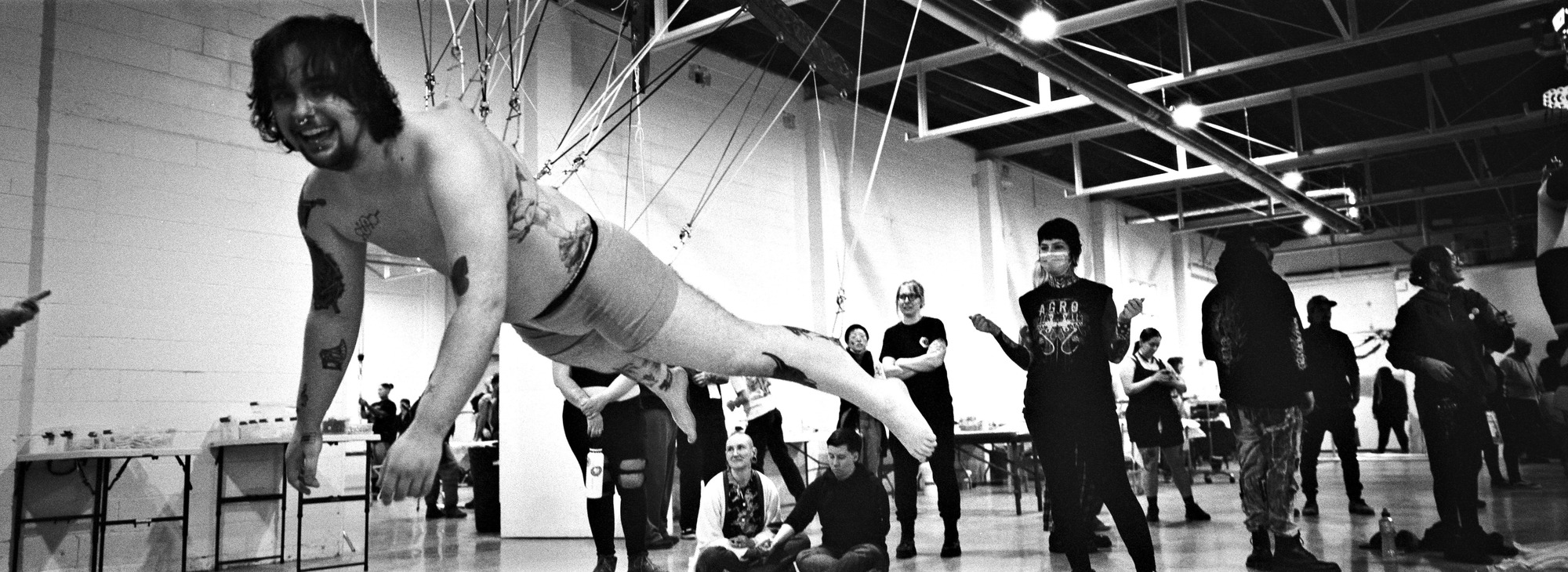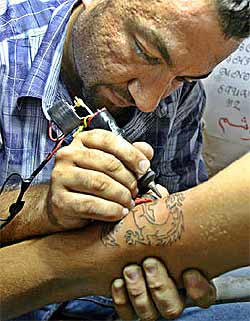|
Fighting For Freedom In Iraq One Screaming Eagle At A Time
I have hope for any culture that allows a tattoo studio to exist. Any culture that permits its people to choose their own tattoos has made a very important statement that is all too rare in this world: the citizens, not the government, own their bodies and have full sovereignty to decide what will become of them. This is the most base and important right that a person could have — and one that people in the US state of Oklahoma still don’t enjoy… unlike Iraqis.
It is true that tribal tattooing has been popular in Iraq for thousands of years — even Saddam Hussein had protective glyphs tattooed on him, and in her book NPR correspondent Anne Garrels describes seeing heavily tattooed Shiite mothers in the overflowing hospitals created by the wars. In addition, after the first Gulf War left so many Iraqis without hands, arms, feet, and legs, Sharia courts which often amputate these parts as punishment started to add tattoos to the foreheads of criminals so that war amputees wouldn’t face the stigma of people assuming they were criminals. But all of this tattooing is very different than what happens in a Western-style tattoo studio. Until recently, all tattooing in Iraq was legally limited to permanent marking designed to uphold social order — that is, the tattoos were for communities, not for individuals. Similarly, Oklahoma permits cosmetic tattooing — that is, tattooing which allies an individual to the group aesthetic. Reuters is currently reporting on Sarmad Shamael, a quiet 29-year old who has a small basement tattoo studio in one of Baghdad’s many rough neighborhoods. Instead of using breast milk and ashes to scratch traditional designs, he uses architect’s ink and a homemade tattoo machine to render the same sorts of images you might see anywhere in America — “Celtic crosses, screaming eagles, and death’s heads” as well as plenty of dragons from a beat-up book of tattoo flash he managed to import.
 Sarmad Shamael at work in his tattoo studio Photo: REUTERS/Ceerwan Aziz The new Iraqi government is certainly no more liberal than Saddam was, but thanks to an almost total collapse of government since the occupation started, Iraqis are operating in a lawless environment — it’s not so much that tattooing has been made legal, it’s more that there’s no one enforcing the laws. As Sarmad puts it, “now people have a choice about what they do, there are no laws to restrict them.” This is true across Iraq as formerly banned industries and subcultures ranging from pornography to heavy metal to pharmacological vices flourish. The mainstream of Iraq — like the mainstream in the West — likes to call them “the bad side of freedom” and debate whether it’s an American conspiracy to corrupt their culture. At first after Saddam’s fall, Iraqi police continued to enact the vice laws, but American MPs, seeing overflowing prisons, forced the Iraqis to release people who committed these crimes and the official raids stopped. The main risk comes from religious vigilantes who have been bombing businesses that they don’t agree with. Al Khayam theatre, near Sarmad’s tattoo studio, has recently began showing adult movies — “In Saddam’s time I had one old night watchman. Now I have three young people armed with Kalashnikovs,” said the manager. Sarmad’s customers as well face resistance to their tattoos, with one 19 year old — tattooed with a scorpion and an American Indian head — describing his father trying to burn his tattoos off with acid. Luckily his mother convinced his father that “the damage was already done,” and now young Mohammed Jasim, presumably having saved up another $15, is back in the rusty metal tattoo chair.
Business is still slow, with Sarmad doing a tattoo only every few days since he opened last April, but he’s improving, and doing his best to control contamination inside his studio. He doesn’t advertise, promoting himself only by word of mouth and the large lion and dragon he’s tattooed on his own forearm underneath the text, in English, “I want to kiss you.” Salman Rushdie recently argued that the level of freedom in a culture can be gauged by its willingness to accept pornography. “Pornography exists everywhere,” he wrote. “But when it comes into societies in which it’s difficult for young men and women to get together and do what young men and women often like doing, it satisfies a more general need. While doing so, it sometimes becomes a kind of standard-bearer for freedom, even civilization.” While I certainly agree with Rushdie, I think at an even more base level, it is tattooing of the individual that is the best indicator of how free a culture is. A culture that tolerates people tattooing themselves as they see fit — not as the law, the tribe (or even the family), or their social stature dictates — is a culture that tolerates the idea that people own themselves. The belief in self ownership, rather than ownership by the tribe, is the first and most important step toward true personal liberty and all that comes with it. Pornography is the second stage of freedom, as it enacts the right to use one’s body as a form of communication with others in any way one sees fit. But both of these freedoms boil down to the same thing — being allowed to do whatever you want, no matter how odd it may seem to others, as long as you’re not hurting anyone else. “A lot of people ask me, why are you so strange,” says Sarmad Shamael, sitting in his little tattoo studio in Baghdad. “I tell them: because I like it.” |
-
Fighting For Freedom In Iraq One Screaming Eagle At A Time [The Publisher’s Ring]
Written by
-
What About When You’re Eighty?
Written by

What About When You’re Eighty?
“Age is something that doesn’t matter, unless you are cheese.”
– Billie BurkeThe Lizardman Q&A columns have been a lot of fun but also a little repetitious of late. So, I have been trying to think of things and ways to make them a bit more fun and new again. Quite frankly, I was at a loss and not sure I was going to do one at all this month. Fortunately, inspiration struck in the form of a comment in one of my journal entry forums by IAM:saram.
The entry (IAM members click here to read it) had been about doing things (body modification or not) on the basis of true personal individual motivation rather than as a result of wanting to fit in or not fit in as the case may be. Sara posted to the effect that she thought these arguments were silly, as I did, and then wrote:
I find other repetitive questions to be far more interesting, like, “How will you feel about [a mod] when you’re eighty?” It’s a silly question, but at least it’s more thought-provoking.
As a result, I then and there promised an article on that very question and realized something that would, at least to me, be a fun potential series of columns. As already stated, the following will be a discussion of that often related query, “what about when you are eighty?” In future months I will be posting other repetitive questions on my IAM page and letting people vote on the next one that I should address. And for fans of the old freestyle Q&A, I am sure it will make a return sometime soon as well.
So, what about when I am, or you are, or anyone else is eighty?
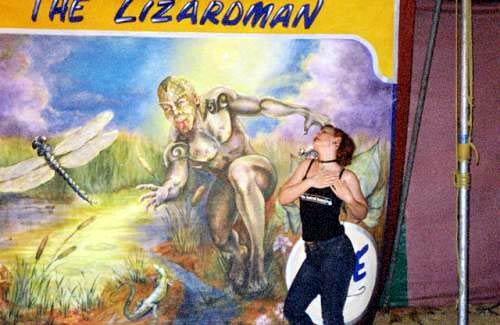
Will women still swoon over an aging Lizardman in 50 years?
I do get asked this question a lot. Most often the motivating factor behind it seems to be a concern or allegation that I have not really considered the consequences and rushed into things. Of course, this is very far from the truth. I spent nearly four years developing, designing, and considering what I was getting into before ever getting tattooed. Even once I had started I broke my overall project up into sections that would allow me reasonable ‘exit points’ if I changed my mind for some unforeseen reason. This means that I spent more time considering this than some people spend together before getting married or having kids. Ask yourself seriously if you think it is more foolhardy to publicly tattoo yourself or to bring a life into the world without forethought?
Explaining all of this and adding that last bit for perspective is often more than enough to satisfy the inquisitor, but if I look at it carefully it does not really answer the question asked — it simply dissolves it by addressing the concerns that motivated the question. Philosophically, being of a Wittgensteinian bent, I love this. But, let’s try actually answering the question itself.
When I am eighty, or however old I live to be since eighty is just an arbitrary age which most people would throw out as a point of getting reflective, being potentially on the way out (which is rather pessimistic since I fully plan on living well past a century), what will it be like to have been tattooed, pierced, and otherwise altered? Obviously, there will be some physical degeneration — that is part of aging despite the best efforts of technology, medicine, and lifestyle. I actually look forward to aging, to living through the process. My modifications may have some unforeseen implications but that’s half the fun (some wrinkling could potentially make scales look that much cooler) and not a deterrent unless they are seriously debilitating. In a somewhat analogous way, I would point to people getting their ears pierced and wearing the very common French hook style jewelry — would putting up pictures of old women’s ears who have been slowly ‘cheese cut’ over decades of wearing these earrings put an end to mall piercing stands? Hardly. The doctor who split my tongue mentioned doing a brisk business of re-working the ears of people who had worn so called ‘normal’ earrings throughout their lives — a nice thing to point out since many of the inquisitors have just such piercings.
The more I think about it, I just don’t believe that people asking the question are at all concerned with a direct answer such as the above. They are more thinking about what type of life you will be leading as you age and what you will be doing to support yourself or such when you reach that ripe age. Even more so, I am all but convinced that the vast majority of people who pose this question are simply looking to play out a superiority trip and accuse people with body modifications of throwing away their lives in some way — especially when it is asked with the implication of future regret.
So what about regrets and quality of life for the modified? Well, it seems like quality of life need not be a problem at all if people would simply be polite and open minded enough to accept that a modified appearance is not necessarily an indicator of much more than personal aesthetic preference. The problem is not my modifications, but your ignorance and prejudice. Given a moment of rational clarity I would hope most people would prefer the eradication of close minded ignorance (on all subjects) to that of something as potentially positive and affirming as body modification. Most regrets will likely fall from the same tree.
Now given that I am not entirely naïve to the world, despite my best efforts to be, and I hope you aren’t either I will discuss regret a bit more pragmatically — regardless of body modification. Wondering ‘what if’ seems to be a wholly natural and likely universal activity for people and is not the same as regret. Often when wondering ‘what if’ you may imagine a scenario much grander than your current reality but this should not necessarily lead to regret. I can honestly say that I have absolutely no regrets at this point in my life because even in those situations where I can ‘what if’ myself into much nicer scenarios for myself and others I still made the best decision I could given my knowledge and options at the time. Just because I look back now at what I know to be bad decisions, I do not regret them since being the exact same situation at that same time again I would do the same thing. Hindsight is 20/20 but unless you intentionally acted in a way you knew to be wrong I do not see cause for regret.
I cannot guarantee that you or I will be happy when we are older but if we act in the best manner we have known and available to us I have very high hopes.
 Erik Sprague
Erik Sprague
because the world NEEDS freaks…
Former doctoral candidate and philosophy degree holder Erik Sprague, the Lizardman (iam), is known around the world for his amazing transformation from man to lizard as well as his modern sideshow performance art. Need I say more?
Copyright © 2004 BMEZINE.COM. Requests to republish must be confirmed in writing. For bibliographical purposes this article was first published August 26th, 2004 by BMEZINE.COM in Toronto, Ontario, Canada.
-
Bena Video Interview [Guest Column]
Written by

Bena
Video interview by Allen Falkner
Over the past few years, my path has crossed with Bena’s several times. However, it was not until the Oslo suscon that I really got a chance to get to know him. Although quiet at first, I soon found Bena to be a witty, intelligent and an extremely articulate individual. From his spirit to his drive to his dedication, I would have to credit Bena as being one of the bigger assets our community has to date.
Bena is a Swedish body modification enthusiast and suspension practitioner that’s works by day as a caregiver for the handicapped. Visit bena on IAM.
The interview below was shot, edited, and conducted by Allen Falkner with additional (not very good) editing by Shannon Larratt.


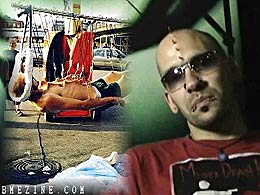

Choose your format (video is just over four minutes long): Video Size Download Size Format Low quality: 240×180 3 meg Windows Media DOWNLOAD Low quality: 240×180 4 meg Apple Quicktime DOWNLOAD High quality: 480×360 22 meg Windows Media DOWNLOAD High quality: 480×360 24 meg Apple Quicktime DOWNLOAD

Allen Falkner (iam:Allen Falkner) is a body piercer with well over a decade of experience and is the owner of Obscurities in Dallas, TX. He is one of the founders of the modern body suspension movement as the progenitor of TSD (and now suspension.org). Allen is credited with the invention — and naming — of much of what people take for granted in modern suspension (including the knee suspension, his signature piece). He’s also a talented photographer and is married to his muse Masuimi Max.
Online presentation copyright © 2004 Allen Falkner and BMEzine.com LLC. Requests to republish must be confirmed in writing. For bibliographical purposes this article was first published online August 26th, 2004 by BMEzine.com LLC in Toronto, Ontario, Canada. Interview took place in Oslo, Norway in August 2004.
-
Being A Modified Jew
Written by

“See, I have engraved You on the palms of my hands”
– Isaiah 49:16
“One shall say, ‘I am the Lord’s,’ and another shall use the name of Jacob, and another shall mark his arm ‘of the Lord’ and adopt the name of Israel.”
– Isaiah 44:5
“I decked you out in finery… I put a ring in your nose, and earrings in your ears…”
– Ezekiel 16:11
See also Exodus 35:22, Numbers 31:50, Judges 8:24, Isaiah 3:21
I fell in love with the art of the tattoo in my early twenties. The choice that I was able to consciously make to beautify my own body was exhilarating. Choosing the placement, selecting the artist and design took research and thought. Seeing the colors and designs come alive on my flesh is intoxicating.But I am a Jew. How does body modification fit into my life?
The answer is: Beautifully.
 Judaism has a long history of distaste for tattoos and piercings. It is my understanding that this stems from the Jewish concept that we are created b’tzelem Elokim (in the image of God) and that our bodies are to be viewed as a precious gift on loan from God, entrusted into our care, but not our personal property to do with as we choose. This distaste grew stronger with the Holocaust and the tattooing that was forced upon the Jews in the prison camps.
Judaism has a long history of distaste for tattoos and piercings. It is my understanding that this stems from the Jewish concept that we are created b’tzelem Elokim (in the image of God) and that our bodies are to be viewed as a precious gift on loan from God, entrusted into our care, but not our personal property to do with as we choose. This distaste grew stronger with the Holocaust and the tattooing that was forced upon the Jews in the prison camps.Let’s discuss a common misconception:
Can you be buried in a Jewish cemetery and participate in Jewish ritual if you are tattooed or pierced?
 It is not prohibited to bury someone who has tattoos or body piercings in a Jewish cemetery. Although the Torah is interpreted by some to prohibit making a permanent tattoo on one’s body, those who violate this prohibition may still be buried in a Jewish cemetery and participate fully in all synagogue ritual.
It is not prohibited to bury someone who has tattoos or body piercings in a Jewish cemetery. Although the Torah is interpreted by some to prohibit making a permanent tattoo on one’s body, those who violate this prohibition may still be buried in a Jewish cemetery and participate fully in all synagogue ritual.I asked IAM member RachelG about her experiences with this and she replied with a personal story regarding being buried in a Jewish cemetery with body modifications:
 “After an unfortunate tragedy where a close modified friend of mine committed suicide, his family was allowed to bury him in an orthodox Jewish cemetery. He was practically fully suited in tattoos and wore three earrings in each earlobe. At the funeral service I spoke at length with the orthodox rabbi who was performing the service about Jews and body modification. He told me that these misconceptions were not only outdated, but any Jew who believed in them was not following the ways of God. Jews are a very accepting and understanding people. Who are we to judge one for intentionally changing one’s body to fulfill their own desires?”
“After an unfortunate tragedy where a close modified friend of mine committed suicide, his family was allowed to bury him in an orthodox Jewish cemetery. He was practically fully suited in tattoos and wore three earrings in each earlobe. At the funeral service I spoke at length with the orthodox rabbi who was performing the service about Jews and body modification. He told me that these misconceptions were not only outdated, but any Jew who believed in them was not following the ways of God. Jews are a very accepting and understanding people. Who are we to judge one for intentionally changing one’s body to fulfill their own desires?” Deliberate, permanent disfigurement of the body would be prohibited. But such practices as ear piercing and cosmetic surgery (such as elective rhinoplasty) are not prohibited. The purpose of cosmetic surgery is to make the body more beautiful, not to disfigure it. (from torah.org)
Deliberate, permanent disfigurement of the body would be prohibited. But such practices as ear piercing and cosmetic surgery (such as elective rhinoplasty) are not prohibited. The purpose of cosmetic surgery is to make the body more beautiful, not to disfigure it. (from torah.org)Being modified does not prohibit you from participating in Jewish ritual. The fact that someone may have violated the laws of kashrut at some point in his or her life or violated the laws of Shabbat would not merit such sanctions. The widely believed prohibition against tattooing is certainly no worse.
 What puzzles and disturbs me is the quote from a rabbi stating that such practices as ear piercing and plastic surgery(1) are not prohibited because they are meant to beautify and not to disfigure. Who is to say that the purpose of my body modifications are not to make the body more beautiful? Is this for a rabbi to decide? I believe that the decision of what makes my body more beautiful is my own. Why is plastic surgery regarded as acceptable and other forms of body modification are not? What about circumcision which is a permanent modification? Who makes those decisions?
What puzzles and disturbs me is the quote from a rabbi stating that such practices as ear piercing and plastic surgery(1) are not prohibited because they are meant to beautify and not to disfigure. Who is to say that the purpose of my body modifications are not to make the body more beautiful? Is this for a rabbi to decide? I believe that the decision of what makes my body more beautiful is my own. Why is plastic surgery regarded as acceptable and other forms of body modification are not? What about circumcision which is a permanent modification? Who makes those decisions? Circumcision is also becoming a challenged ritual within Judaism as more and more Jews regard this practice as a social choice. This is a major body modification and disfigurement to a small child that is not given the choice to modify. It is also common practice among non-Jews to circumcise a male newborn penis, and this practice is not specifically Jewish, though it is common practice among Jews specifically. For more information on the complex issue regarding facts and myths of Jewish ritual circumcision, I invite you to visit jewishcircumcision.org. There are many modern changing views concerning the modification of infants without their consent.
Circumcision is also becoming a challenged ritual within Judaism as more and more Jews regard this practice as a social choice. This is a major body modification and disfigurement to a small child that is not given the choice to modify. It is also common practice among non-Jews to circumcise a male newborn penis, and this practice is not specifically Jewish, though it is common practice among Jews specifically. For more information on the complex issue regarding facts and myths of Jewish ritual circumcision, I invite you to visit jewishcircumcision.org. There are many modern changing views concerning the modification of infants without their consent. For many people, conscious modification has become a way for them to take ownership of the beauty of their own bodies. For a very long time I felt uncomfortable in my own body. I was too fat, too short, my breasts were droopy — I could come up with a list a mile long. I discovered through modification that I loved my own body more when I got to choose what was happening to it. I would not knowingly disfigure my body. I intend to beautify it at my discretion. I am not the only one and I am far from the only modified Jew. By choosing to tattoo my body, I also feel that I am reclaiming this ritual for beauty rather than the hate and disrespect that was the intent of the Nazis forcibly tattooing the Jews during the holocaust.
For many people, conscious modification has become a way for them to take ownership of the beauty of their own bodies. For a very long time I felt uncomfortable in my own body. I was too fat, too short, my breasts were droopy — I could come up with a list a mile long. I discovered through modification that I loved my own body more when I got to choose what was happening to it. I would not knowingly disfigure my body. I intend to beautify it at my discretion. I am not the only one and I am far from the only modified Jew. By choosing to tattoo my body, I also feel that I am reclaiming this ritual for beauty rather than the hate and disrespect that was the intent of the Nazis forcibly tattooing the Jews during the holocaust. My Judaism and my body modification go hand in hand for me. They are both part of who I am and how I represent myself. I am a tattooed Jew. I am proud of both of these facets of my life. I am not ashamed to go to Shul and I am not afraid of the questions. What I dislike is the assumption that I am not as good a Jew because of my modifications. I completely disagree. What I dislike is the prejudice my own Jewish people bestow upon me, and others, for choosing to reclaim the ancient art of body modification. This in itself does not convey the Judaism of acceptance that has always been expressed to me in Shul. I believe this inter-judaic prejudice stems from a sociological prejudice thinly veiled by a misunderstood religious excuse.
My Judaism and my body modification go hand in hand for me. They are both part of who I am and how I represent myself. I am a tattooed Jew. I am proud of both of these facets of my life. I am not ashamed to go to Shul and I am not afraid of the questions. What I dislike is the assumption that I am not as good a Jew because of my modifications. I completely disagree. What I dislike is the prejudice my own Jewish people bestow upon me, and others, for choosing to reclaim the ancient art of body modification. This in itself does not convey the Judaism of acceptance that has always been expressed to me in Shul. I believe this inter-judaic prejudice stems from a sociological prejudice thinly veiled by a misunderstood religious excuse.How did my family react?
 My family ignores it. Don’t ask, don’t tell — sound familiar? — but still love and respect me as who I am. My family’s beliefs are those of conservative Jews and I respect them for that. However, I follow more of a Reconstructionist view. Reconstructionists define Judaism as the evolving religious civilization of the Jewish people and most Jewish people, including Reconstructionists, no longer accept its binding authority. While Reconstructionists are lovers of tradition and support community celebration of the Jewish sacred year and life-cycle events, we also believe that the face of the Jewish community is changing and that individuals have the right to adapt Jewish tradition to new circumstances. That doesn’t make us any less Jewish than those who live by Conservative or Orthodox law (although there would be plenty of argument within Judaism about this).
My family ignores it. Don’t ask, don’t tell — sound familiar? — but still love and respect me as who I am. My family’s beliefs are those of conservative Jews and I respect them for that. However, I follow more of a Reconstructionist view. Reconstructionists define Judaism as the evolving religious civilization of the Jewish people and most Jewish people, including Reconstructionists, no longer accept its binding authority. While Reconstructionists are lovers of tradition and support community celebration of the Jewish sacred year and life-cycle events, we also believe that the face of the Jewish community is changing and that individuals have the right to adapt Jewish tradition to new circumstances. That doesn’t make us any less Jewish than those who live by Conservative or Orthodox law (although there would be plenty of argument within Judaism about this). I think that the belief that body modification is prohibited by the Torah is antiquated, just as other Biblical laws are (and have thus been adjusted to fit modern times). Judaism is evolving in some sects; no longer do we have to hide what may be seen as “against the Torah” to practice our faith. It is quite a relief to do so. If you choose to practice your faith, there are many ways to do so. When you are dealing with Orthodox, Reform, Reconstructionist and Conservative movements, we will not agree on each others interpretation of the Torah.
I think that the belief that body modification is prohibited by the Torah is antiquated, just as other Biblical laws are (and have thus been adjusted to fit modern times). Judaism is evolving in some sects; no longer do we have to hide what may be seen as “against the Torah” to practice our faith. It is quite a relief to do so. If you choose to practice your faith, there are many ways to do so. When you are dealing with Orthodox, Reform, Reconstructionist and Conservative movements, we will not agree on each others interpretation of the Torah. Body Modification is just as much a part of my life as my faith in Judaism. I believe that my modifications beautify my body and bring joy to my life. They do not take away from my faith in God. My personal practice allows me to be who I am, and I wouldn’t have it any other way.
Body Modification is just as much a part of my life as my faith in Judaism. I believe that my modifications beautify my body and bring joy to my life. They do not take away from my faith in God. My personal practice allows me to be who I am, and I wouldn’t have it any other way.Liz Polay-Wettengel
1 Editor’s note: It should be added that rhinoplasty has been historically a “Jewish” procedure with the goal of masking — publicly destroying — the Jewish identity in the face of bigotry. One could make the argument that tattoos that uplift the Jewish identity are a far better way to serve God than rhinoplasty ever could be.
 Liz Polay-Wettengel (iam:TattooedRedhead) is an executive general manager in Boston Massachusetts where she lives with her husband and two cats. She has a professional background in the music business and writes for several online blogs. Liz has been an active member of the IAM BME community since 2000 and currently runs the membership sponsorship forum and the Jew Crew community forum.
Liz Polay-Wettengel (iam:TattooedRedhead) is an executive general manager in Boston Massachusetts where she lives with her husband and two cats. She has a professional background in the music business and writes for several online blogs. Liz has been an active member of the IAM BME community since 2000 and currently runs the membership sponsorship forum and the Jew Crew community forum.Online presentation copyright © 2004 Shannon Larratt, Liz Polay-Wettengel, and BMEzine.com. Requests to republish must be confirmed in writing. For bibliographical purposes this article was first published online August 19th, 2004 by BMEZINE.COM in Toronto, Ontario, Canada.
-
Muffe Vulnuz Video Interview [Guest Column]
Written by

Muffe Vulnuz
COPENHAGEN BODY EXTREMES
Video interview by Allen Falkner
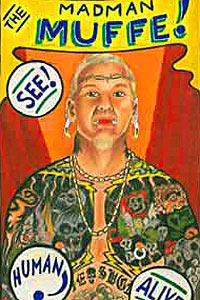
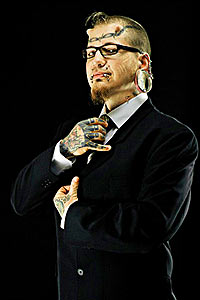
“The traveler has to knock at every alien door to come to his own, and he has to wonder through all the outer worlds to reach the innermost shrine at the end.”
– Rabindranath
TagoreI just returned from the Wings of Desire suspension convention in Oslo, Norway. Attendees from eight countries — Norway, Sweden, Denmark, Holland, Belgium, England, USA, and Russia — (and almost as many languages) met for lectures, performances, and suspensions.
Muffe Vulnuz, a self-proclaimed “crusty punk” from Denmark, is definitely one of the most interesting people I met while attending the Oslo Suscon. Muffe is the owner and piercer of Copenhagen’s Body Extremes as well as a suspension practitioner and performance artist. Honestly, there were too many wonderful people from convention to list them all, but if I had to narrow it down, I would say that Muffe was one of my favorite people I met that weekend.
Thanks as well to my hosts Håvve (iam:bleeding) and Christiane (iam:christiane).
The interview below was shot, edited, and conducted by Allen Falkner with additional editing by Shannon Larratt. Performance video footage (the intro and pip footage) is c/o Muffe — you can download it on its own and see other pictures at his website bodyextremes.com… or visit him in Copenhagen!
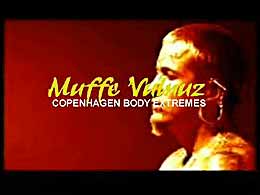



Choose your format (video is seven and a half minutes long): Video Size Download Size Format Low quality: 240×180 5 meg Windows Media DOWNLOAD Low quality: 240×180 6 meg Apple Quicktime DOWNLOAD High quality: 480×360 47 meg Windows Media DOWNLOAD High quality: 480×360 46 meg Apple Quicktime DOWNLOAD

Allen Falkner (iam:Allen Falkner) is a body piercer with well over a decade of experience and is the owner of Obscurities in Dallas, TX. He is one of the founders of the modern body suspension movement as the progenitor of TSD (and now suspension.org). Allen is credited with the invention — and naming — of much of what people take for granted in modern suspension (including the knee suspension, his signature piece). He’s also a talented photographer and is married to his muse Masuimi Max.
Online presentation copyright © 2004 Shannon Larratt, Allen Falkner, and BMEzine.com LLC. Requests to republish must be confirmed in writing. For bibliographical purposes this article was first published online August 18th, 2004 by BMEzine.com LLC in Toronto, Ontario, Canada. Interview took place in Oslo, Norway in August 2004.
-
Stelarc Video Interview: TransVision 2004 [The Publisher’s Ring]
Written by

Stelarc Video Interview
TRANSVISION 2004 COVERAGE: PART TWO
“We mostly operate as Absent Bodies. That’s because a body is designed to interface with its environment — its sensors are open-to-the-world (compared to its inadequate internal surveillance system). The body’s mobility and navigation in the world require this outward orientation. Its absence is augmented by the fact that the body functions habitually and automatically. Awareness is often that which occurs when the body malfunctions.”– StelarcAustralian performance artist Stelarc has been doing public suspensions since the 1970s. He is literally the first face many people who are now “elders” in the suspension movement came in contact with, although his use of suspension is very different than the standard we seem to have settled on more recently.
In 1987, two years before RE/search released Modern Primitives, Adam Parfrey’s Apocalypse Culture hit the shelves. My father bought me a copy, highlighted the opening quote — “There is nothing more terrifying than stupidity – Werner Herzog” — and that now beat up copy still rests on my bookshelf. Amid articles on eugenics, nuclear war, modern fascist movments, schizophrenia, and child molestation, was an interview with Fakir Musafar somewhat derisively discussing Stelarc.
While they’d later find a common ground for discussion, at the time Fakir was none-too-kind, writing,
“He has a tremendous amount of guts, but I think his civilization varnish has not been scrubbed enough. He is capable of enduring things longer than he does. If he hung for a longer length of time, he’d have a mystical experience. I can’t help to think that he may have had one or been on the border and it scared the hell out of him. So he limits the length and calls it art. What he’s dabbling in is magic technology.”
But it was enough to get a generation desperate to find literature on something that was calling to them seeking out Stelarc. A few years earlier (1984) Stelarc had released Obsolete Body: Suspensions, a book of writing and photos on flesh hook suspension, using the body as a sculptural installation in various art spaces (and public spaces as well). As much as Fakir expressed dismay at Stelarc’s refusal to embrace the spiritual application of suspension, Stelarc had become — without even knowing it at the time — one of the modern suspension movement’s godfathers. Back then, only he and Fakir were out there doing it publicly and sharing their experiences.
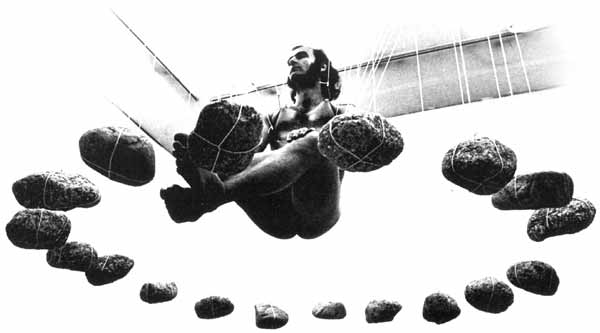
TOKYO – 11 MAY 1980. PHOTO: KENJI NOZAWA
“The insertions were done with the body laying on the floor, below a halo of rocks which had been suspended from eye-bolts in the ceiling with slip-knots. When everything was connected the cords were tugged, releasing the rocks. As the rocks came down, the body went up. The body started to gently sway from side to side, triggering random oscillations of the ring of rocks. Everything was in motion, balanced and buoyant. Everything was connected and and contained. Thoughts of obsolescence flickering in and out of the silence. The telephone rings. Murmurs. Distractions. Sitting, suspended and anxious.”
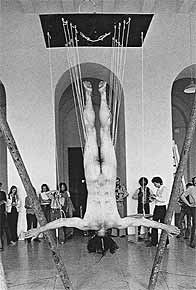
MUNICH – 8 AUGUST 1977
PHOTO: HAROLD RUMPF
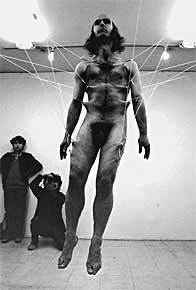
TOKYO – 12 MARCH 1978
PHOTO: TONY FIGALLO
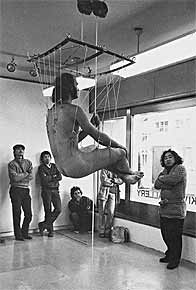
TOKYO – 2 MARCH 1980
PHOTO: NINA KUO
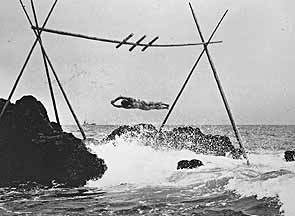
MIURA – 30 MAY 1981PHOTO: ICHIRO YAMANA
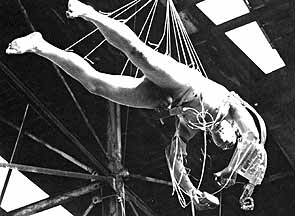
YOKOHAMA – 29 MAY 1988
PHOTO: SIMON HUNTER
STELARC’S FINAL SUSPENSION
I finally had a chance to meet with Stelarc in person at TransVision 2004 in Toronto (click here for part one of our TransVision coverage) where he was giving a presentation on his work. Stelarc is friendly and approachable, and most of all down to earth with an easy boisterous laugh. At his talk he covered everything from his early suspension work (which ended in 1988, a decade before the suspension mainstream would boom) and “third hand” experiments (a fully functional third hand, controlled by nerves in other parts of his body).
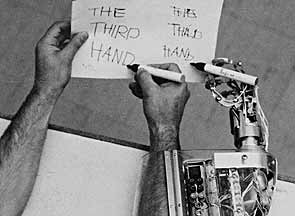
TOKYO – 8 MAY 1981
PHOTO: JUN MORIOKA
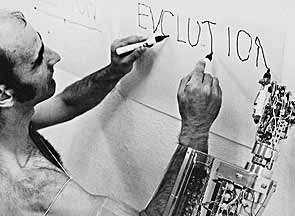
TOKYO – 22 MAY 1982
PHOTO: AKIRO OKADA
“Whilst the body activates its extra manipulator, the real left arm is remote-controlled and jerked into action by two muscle stimulators. Electrodes positioned on the flexor muscles and biceps curl the fingers inwards, bend the wrist and thrust the arm upwards. The triggerings of the arm motions pace the performance and the stimulator signals are used as sound sources, as is the motor sound of the Third Hand mechanism itself.”
Stelarc also discussed his exoskeletons and robot appendages, and his work with electric muscle stimulation, including pulling “volunteers” out of the audience, wiring them to his control box, and forcing them to dance — any attempt to resist his commands were met with pain, increased voltage, and eventually failure as they involuntarily moved exactly as he choreographed. In previous performances Stelarc has wired himself with these devices and been controlled by both audiences and other factors like Internet ping times.
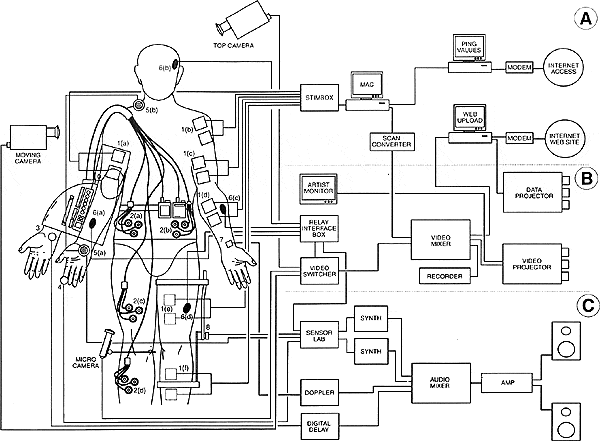
“During the Ping Body performances, what is being considered is a body moving not to the promptings of another body in another place, but rather to Internet activity itself — the body’s proprioception and musculature stimulated not by its internal nervous system but by the external ebb and flow of data. Ping values from 0-2000 milliseconds (indicative of both distance and density levels of Internet activity) are used to activate a multiple muscle stimulator directing 0-60 volts to the body. Thus ping values that indicate spatial and time parameters of the Internet choreograph and compose the performances. A graphical interface of limb motions simulates and initiates the physical body’s movements. This, in turn, generates sounds mapped to proximity, positioning and bending of the arms and legs.”
Stelarc also showed some of the work he’s been doing on his “third ear” project, in which a replica of his own ear will be implanted into another part of his body — instead of listening though, this ear may talk instead. Helped by Oron Catts and Ionat Zurr of Tissue Culture & Art, Stelarc has been “growing” these replica ears inside biotumblers as his own cells permeate a polymer latice. Finally, Stelarc also showed his avatar projects (an Alice-based communication system coupled with a very creepy animation of his head), allowing computers to speak on his behalf as him.
After TransVision, Stelarc and I were able to sit down for an interview to talk both about his suspension work and his other art. I’d like to present that video now. It’s 45 minutes long so the file sizes are quite large. Please save it to your computer, rather than trying to view it in your browser!




Choose your format: Video Size Download Size Format Low quality: 320×240 30 meg Windows Media DOWNLOAD Low quality: 320×240 37 meg Apple Quicktime DOWNLOAD High quality: 480×360 132 meg Windows Media DOWNLOAD High quality: 480×360 124 meg Apple Quicktime DOWNLOAD That’s actually the first real video I’ve edited using Avid, so I apologize for any errors. While you’re waiting for it to download, I’d like to strongly urge you to go and browse Stelarc’s website at www.stelarc.va.com.au, as the interview assumes a basic knowledge of his work. Not only is Stelarc one of the seeds of the suspension movement, but he’s also an important seed in cyborg culture, distributed intelligence, technoethics, and other fields he likely never knew he was even performing for.
Edit/Update (October 2012) – I’ve posted this to YouTube here:
Thanks to Stelarc of course, and to Philip Barbosa for videotaping the interview and presentation, and thanks to Bo De Duyen for allowing us to film there. Thank you as well to everyone from BetterHumans and the WTA for inviting us in the first place.

Shannon Larratt
BME.com
-
TransVision 2004 Coverage: Part One [The Publisher’s Ring]
Written by

TransVision 2004 Coverage
PART ONE: A RAMBLING OVERVIEW OF TV2004
“Transhumanism is a way of thinking about the future that is based on the premise that the human species in its current form does not represent the end of our development but rather a comparatively early phase.”
– Prof. Nick Bostrom, Oxford University
IMAGE SIDEBAR
Below are a few photos we took at TransVision. I felt a little bit like a “science groupie” asking people to let me take a photo with them, but hey, it was exciting for me! I should also note that in this article I’ve barely skimmed the surface of most of these brilliant minds — I strongly encourage you to check out their websites and google them for more.
Steve Mann (wearcam.org) speaking about wearable computing, glogging, and sousveillance. I really urge you to visit his websites to learn more about how he’s augmenting and mediating the human experience using a cyborg body.
João Pedro de Magalhães of Harvard Medical School talking about his work in trying to find — and one day cure — the genetic causes of aging. You can see in this picture how unfortunately empty the event was.




Dr. Rafal Smigrodski (Gencia Corporation) talking about his work on mtDNA replacement which could cure diseases such as Parkinson’s, Alzheimers, and diabetes, as well as dramatically extending lifespans.



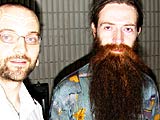
Biogerontologist Aubrey de Grey talking about life extension by “cleaning” our cells of the toxic aggregates that our bodies are currently unable to deal with. Great beard, great mind.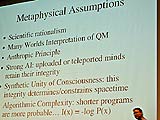
Allen Randall’s talk on “Quantum Miracles and Immortality” included discussion of a number of amusing thought experiments. In simple terms, quantum theory suggests that all possible states exist at once (ie. there are multiple worlds, like in that show Quantum Leap). Therefore, if you try to kill yourself in a way that has an (impossibly high) high chance of success in every one of these worlds, only the immortals survive — thus creating a quantum state that favors your immortality. I’m not really sure if this talk was supposed to be serious or just really funny, but I enjoyed it and I’ve always been a sucker for philosopher mathematicians.
Torsten Nahm from Bonn, Germany talking about aging, and arguing that being biological (wetware) sucks because of that aging. By moving into a digital form, we can become immortal, make backups of ourselves, experiment with different lives, and anything else we’d like. However, we need to decide whether the transition from one form of being to another involves not only rebirth, but death.
Ben Hyink’s talk on preserving network integrity during the process of uploading. That is, how do you keep an entity alive and conscious as it transitions into a new body? Unfortunately like many of the plenary talks, Ben was not able to fit all of his interesting ideas into the allotted time.


Anders Sandberg introducing Nick Bostrom’s closing talk. I first interviewed Anders for BME back in I think 1996. Anders’s enthusiastic online promotion of transhumanism has introduced thousands and thousands of people to a more forward-leaning way of thinking. I really liked Anders, although I only got to speak to him briefly. Super nice guy… actually, everyone I met at the event was really nice.






Nick Bostrom of Oxford University and the WTA puts transhumanism — and our need to embrace it — in simple and convincing terms in his closing talk. Nick is also the author of the transhumanism FAQ which is an excellent introduction to the subject along with Anders’s pages.With George Dvorsky of Betterhumans, one of my hosts (Simon had already slipped out; I’d hoped to include both of them). As well as his work with Betterhumans, you may also want to check out his personal site and blog.

With Rudi Hoffman, “Cryonics Insurance Specialist”. I really got a kick out of Rudi — as much as he’s a real cliché of a salesman, he’s a a lot of fun and an incredibly enthusiastic spokesman for jumping into the future by jumping into a vat of liquid nitrogen. Contact Rudi if you’re trying to find an affordable way to have your brain — or entire body — frozen Futurama-style.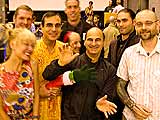
A group photo taken near the end of the event. Shannon Bell is on the far left (when I mentioned that Shannon had joined us to friends, they were extremely excited — she has a reputation for being one of the best professors you can have at York University, as well as being a distinguished author and researcher). In the middle of the front row is Stelarc who you’ll meet in more detail in part two of this article, and between them is José Luis Cordeiro who will be hosting TransVision 2004 in Caracas, Venezuela.
Transhumanism, at its simplest, is a way of thinking and being that embraces the idea that our experience as homo sapiens is just one small step in an ongoing evolution, and that we should take an active rather than passive role in “making ourselves better”. Transhumanists are a mix of philosophers, futurists, sci-fi buffs, and bona fide scientists advocating ideas such as uploading (the transfer of consciousness into computers), genetic enhancement, immortality, machine-human integration, and nanotechnology. Body modification culture lies on a related path and represents a real-world application of breaking the biological mold and transforming ourselves into something we perceive as “better” than what nature gave us.TransVision, the yearly convention of the World Transhumanist Association, took place in Toronto, Canada for 2004 and BME was there thanks to an invitation from our friends over at BetterHumans. It took me a moment to actually figure out where it was being held, because nowhere on their website did it list an address or even the name of the building that was being used — but, after a bit of googling for the JRR McLeod Auditorium, we made our way to the University of Toronto Medical Sciences Building.
The conference had drawn speakers from all over the world — a sizable European and Scandinavian contingent, South Americans, and of course plenty of Canadians and Americans. It seemed to touch on every demographic from young fashionable cyberpunk kids, übergeeks, scientists, artists, and one seeming half-wit conspiracy nut that asked “how many methods of human improvement are there”, besides “chemical augmentation” (which he certainly seemed to be enjoying) at every talk he attended. One thing that surprised me was how empty the event was and how few people other than the speakers seemed to be there — many of the talks I would attend had less than twenty people sitting in the auditorium, with most of the seats empty.
After picking up our press passes, Phil Barbosa (who’d joined me to help film the event) and I went to the front row to wait for the opening talk by Steve Mann to begin. Steve Mann is the real deal. A genuine geek that looks every bit the part, Steve Mann has lived with wearable computing and camera technology since the mid 1970s and is a leading — and seed — researcher in these fields. He’s vehemently anti-corporation, is a political activist on surveillance issues, as well as being an environmentalist using guerrilla installations of solar cells and wind turbines.
Mann concentrated his talk on what he’s best known for: glogging, or “cyborg logging”, a form of literature (if that’s the right word) that predates but closely resembles blogging and moblogging and mandates that the glogger extend their body and consciousness into artificial and reconfigurable appendages. Using his wearable computing and media system, sometimes in collaboration with other cyborgs, he explores, documents, and shares his view of the world he sees. His inverse surveillance or sousveillance (“watching from below”) regularly brings him in conflict with those watching from above — he observes that those who run their own surveillance cameras are usually those most offended at his sousveillance of them in return. Mann went on to talk about “dusting”, a slightly improved version of an additive compositing technique that’s been in common use since the beginning of photography, which he seemed to think was important. This illustrated one of the pitfalls about becoming so engrossed in personalized technology while being heralded as the primogenitor — a difficulty in recognizing or taking seriously work done by other researchers.
As much as Steve Mann gave a largely brilliant talk, it also illustrated a fundamental problem in passing knowledge and ideas from hardcore geek culture to the mainstream: it’s not that charismatic (Reason magazine described Mann as “rather creepy” and spoke of him derisively in their event report). Steve displays a sense of humor that’s highly personal and a difficulty in communicating with other humans, which is genuinely ironic given the amazing tools he’s helped developed to facilitate these communications. His websites are ugly and primitive, the photos of him wearing his inventions are “unflattering” to say the least, and he uses common terms in ways that are awkward and unconventional (such as his insistence that Linux and other open source programs are not software, because wares are items of commerce — better tell that to the open source software movement). The best chefs understand that the way they present their dish greatly affects diners perception of it… Scientists need to embrace the reality of human interaction and start to include marketing as an important part of transhumanist dialog. Body modification for example is successful not just because it’s “right”, but also because it’s cool and accessible.
The title of Steve Mann’s talk had been “Glogging: Sousveillance, Cyborglogs, and the right to self-modification.” The right to self-modification is of course something that I’m very concerned about since it affects the readers of BME (and myself) on a daily basis, and is one of the key points where transhumanism and body modification intersect. Ultimately if we’re going to leap forward from these dirty ape fleshbag bodies of ours, we have to embrace the right of every individual to transform themselves in any way they see fit, be it a split tongue or be it a robotic tongue. Unfortunately, Mann hadn’t mentioned a word about it in the talk, which I found odd given that it was part of the title, so I asked him about it afterwards — given that in many parts of the Western world, even traditional “self-modification” like tattooing is illegal, was there any movement inside transhumanist circles to politically fight for the right to self-modification?
While Mann didn’t know of any such battle, he does have an interesting counter-attack to those who tell him he has to remove the electronic parts of his body — he says “sure, but only if you sign this form assuming liability if I’m injured due to not having them.” It’s a curious idea — if an augmented human is “more” than an unaugmented human, does that mean that in relative terms a normal human is handicapped? Is taking a cyborg’s electronics away the same as telling someone they can’t wear their glasses, or can’t ride on their electric wheelchair? Since we can always improve, where does one draw the line — and should one draw such a line at all? If we’re thinking along such paths, is not genetically improving your child a modern form of child abuse? Or will political correctness force us to define “human” as “stupid and limited, and that’s how we like it?”
Later in the conference I attended a talk by Dr. Rafal Smigrodski, a specialist in mitochondrial genome manipulation. In “how to buy new mitochondria for your old body” he describes what he believes could add a decade or more to people’s lifespans, as well as curing many mitochondrial disorders using a technique not so different from the Keith Richards urban legend in which he solves his heroin addiction by flying to Switzerland where all of his blood is removed and completely replaced with new, healthy, and unaddicted blood. Dr. Smigrodski touched on the right to self-modify issue as well, pointing out that he’s been forced to concentrate his research on those with diseases or otherwise improperly functioning physical forms — and that convincing governments that aging is a disease will be far from an easy thing, even though aging appears to be a terminal condition that we all suffer from. I think it was Nick Bostrom that would say later in his closing remarks that most people have a Stockholm Syndrome type relationship with aging, whereby they give artificial value to that which has imprisoned them.
From my point of view, the right to self-modify is something that transhumanist researchers should be embracing. It’s all well and good to develop technologies that ease the suffering from extremely rare disorders, and maybe that gives us “expendable” people to experiment on (it’s a terrible way to put it, but if we use the ill as fair game to do our early experiments on, that is what we’re doing), but until these technologies are available in unrestricted form to the general public, they’re not particularly transhumanist. Perhaps I’m speaking callously, but in my opinion, if we’re to move humanity forward, we should be concentrating on transforming the best of humanity into something even more, rather than trying to alleviate suffering in that tiny, tiny minority of people who are born with terminal or crippling diseases.
Aubrey de Grey as well gave a fascinating talk on “removing toxic aggregates that our cells can’t break down”, but he as well must face these same issues — how do you start using these technologies to enhance humans, rather than just fixing them when they break? I don’t want to keep repairing my old Ford Escort… I want an upgrade to a flying Lamborghini.
I’d come into the conference assuming that most transhumanists shared my own views: that we should be aggressively transforming humans into the things we dreamed of as children slumbering after spending the day reading science fiction, beings with far more power and options than we have as humans. However, there’s certainly no agreement inside transhumanism that this is the right goal. Mark Walker, editor of the Journal of Evolution and Technology and research fellow at Trinity College, spoke on the Genetic Virtue Program which he proposes is “the only hope on the horizon that humans might remove themselves from the slaughter bench of history.”
The basic idea is that since behavior is at least thirty to forty percent inherited (so you will act like your parents) and thus genetic in nature, that by using genetic manipulation we can, in time, breed a race of humans that are more compassionate and loving, and less aggressive, greedy, and prone to lying (and presumably sinning). While there is a certain truth to Walker’s proposals, the idea of using science to limit humans rather than expand them wasn’t really received that well by the audience. I pointed out that historically progress tends to be made by selfish, aggressive, and sometimes even “evil” people, and that breeding a society of well behaved losers might not be in our best interests as a species. One neurologist in the crowd pointed out that the ability to lie was an important part of an advanced mind, closely linked to the ability to consider different variations on the same idea, and that attempts to genetically force moral behavior might have to sacrifice intelligence in exchange — but Walker’s ideas certainly underscore the fact that there are a myriad of ways to move humanity forward (as well as many definitions of “forward”), and that transhumanism covers a very broad range of politics and faiths.
As is probably clear, I enjoy the hard science, and I believe that we must embrace the absolute right to use that science to better ourselves. To me, that’s the whole point — if all science does for us is fix people who are born “broken”, then we’re actually moving in the wrong direction. While I certainly hope that we can care for all people, if resources are going to be poured into improving humanity, I’d like to see it poured into improving the best humans, thereby moving us into the future. Because of this, I was looking forward to seeing Natasha Vita-More’s “posthuman prototypes debate their own design.”
When Natasha got on stage, more flash bulbs went off than at any other talk I’d been to. With zoom lenses fully erect, an army of transhumanist men showed they were still slaves to testosterone — Natasha lives in a transhumanist body herself with obviously “augmented” mammalian features and a clear attention to fitness and form. I don’t say this to be crass — the mass appeal of extreme cosmetic surgery is very relevant to transhumanist bodies and I was looking forward to hearing her thoughts on it. Unfortunately her talk was rubbish and full of sloppy thinking and inadequate research. She’d “interviewed” a number of fictional and non-fictional post humans, including her own imaginary creation “Primo”, Agent Smith from The Matrix, and Honda’s Asimo robot.
She “asked” these entities what they thought about themselves, humans, and so on, and in her answers made it clear that she had little comprehension of the technology involved, and was primarily interested in making her own sadly uninformed comments. Most obviously she claimed that Asimo was a primitive machine that could do no more than walk up and down stairs, a foolish statement to put it politely. Her commentary on the other technologies was equally ignorant, and her own “Primo” creation showed that she couldn’t even use the terminology correctly (ever get annoyed at the technobabble in Star Trek?) let alone illustrate it in a way that anyone can take that seriously — even if you’re just an “artist”, you still have the responsibility to understand the language you’re speaking. This saddened me, because Natasha is clearly a brilliant and creative women, but she disgraces herself when she speaks so foolishly.
Unfortunately Natasha was not the only person speaking this way at TransVision. I suppose that’s to be expected when you have a wide range of people commenting on such a diverse subject, but what disturbed me about it was that few inside transhumanism seem to have the courage to shout out “the emperor wears no clothes”, but instead seem to prefer a circle-jerk where everyone congratulates each other on how clever they are with little willingness to look at the thoughts critically — although they’ll galdly rip to shreds outsiders who criticize them.
In my opinion, transhumanism doesn’t need ill-informed people who go off on flights of “what if” fancy. You know what? All of us have been doing that since we were five years old. What transhumanism needs is transhumanists. Not people who talk about. People who do it. I have enormous respect for people like Steve Mann and Stelarc (or Todd Huffman with his magnetic vision) who are actually out there living transhuman lives and having transhumanist experiences, rather than just talking about them without any first-hand knowledge, as well as the scientists doing the foundation research that will make it possible. I am not convinced that the philosophers and artists are any different from science fiction authors — an important element in inspiring people to live as transhumanists, but no more than that.
As much as the conference was utterly unpromoted and almost unattended, there was an abundance of fascinating characters. Sitting next to me at several of the events was the boisterous and friendly Rudi Hoffman who was there selling life insurance for those seeking cryogenic suspension with Alcor — for about $40 a month you can buy an insurance policy ensuring that upon death you’ll be frozen a la Han Solo. Unfortunately the insurance doesn’t cover the cost of bringing you back to life — it’s hoped that future generations will do so for you. But still, your chances for reincarnation, as slim as they may be, are a lot better if you’re preserved in a vat of liquid nitrogen than if you’re rotting in a pine box buried in the ground.
Also sitting next to me — in the front row — for several of the talks was a tall, slender Asian man with a big bag of groceries. Oblivious to those around him, he prepared and ate several salads and fruit dishes, carefully weighing them and then entering them into a spreadsheet on his laptop as he ate, afterwards spending ten minutes loudly flossing his teeth. This seemed to me to be a strange thing to do, and by their strained glances at him, I think some of the speakers were debating whether or not they were being insulted. Later I discovered that he believed that in order to best achieve longevity one should adopt a paleolithic diet, since that’s what our bodies are presumably evolved to survive on.
Meeting José Luis Cordeiro, the host of TransVision 2005 (to be held in Caracas, Venezuela) was rewarding as well. Cordeiro has written extensively on both transhumanism and the socio-political future of Latin America, but even though his books sell well from Mexico southward, he’s had little luck reaching the North American market — as he opined in a seminar on writing transhumanist books (moderated by Simon Smith) information flows out of America, but rarely in. I believe that Cordeiro is exactly what transhumanism needs — an optimist (but a realist) with a technical background, and with a sense of humor and the charisma required to present far-out ideas to the general public.
All this said, I really must encourage readers to take advantage of events like TransVision when they happen in your area. Don’t underestimate the value of getting to meet world class thinkers — even the ones you disagree with — in person. Don’t underestimate the value of introducing yourself into dialogs you might otherwise not be able to have. As much as I didn’t think much of a few of the presenters, the ones I disagreed with the most are also the ones that got me thinking aggressively about where humanity is going and how we should take it there.
Finally, if I could say one thing to transhumanists in general, it is to follow Steve Mann and Stelarc’s example and make it real. Don’t just talk about far future fantasies. Taking the first step may not be as fantastical as masturbating over the year 3000, but it’s the only way that we can force transhuman evolution without being restricted by governments and corporations, who will act in the best interests of nationalism and capitalism, rather than humanity’s future. While it’s true that we’ll see the occasional Mr. Hyde as a result, I call out to Bruce Banner: it’s time to irradiate yourself.

Shannon Larratt
BME.com
-
The World’s First Piercing Magazine [Running The Gauntlet – By Jim Ward]
Written by

VIII. The World’s First Piercing Magazine
Chronologically this article should have preceded the previous one because Gauntlet had published several issues of its piercing magazine before the opening of the store. The reason for the slight detour will be explained a little later.
When I first started Gauntlet, publishing a piercing magazine couldn’t have been further from my mind. But it quickly presented itself as a very natural aspect of the work I was doing. As piercing enthusiasts began hearing about Gauntlet, a typical type of correspondence started to arrive in the mail on a regular basis.
Up to that time people who were into piercing were pretty much on their own. If they wanted a piercing they had to figure out how to do it themselves or get a sympathetic friend to assist them. There was no readily available resource for information on piercing technique or for the tools and materials to do it. In general the results were less than satisfactory. Piercing enthusiasts were also widely scattered all over the globe and for the most part very closeted.
Consequently many of the letters I received contained the same two questions: First, how do I pierce my or my girl/boyfriend’s insert name of piercing here? Second, how do I go about meeting other people into the scene? Needless to say answering these questions repeatedly made it quickly apparent that there had to be an easier, more professional way to meet the demand. The obvious solution was a magazine. Since there was clearly a growing interest in piercing, why not?
My artistic background aside, I had no knowledge or experience along this line. Perhaps if I had, I might have thought twice about pursuing the matter, but like a rushing fool I began making plans and gathering the information and resources I needed.
Early in the days of the T&P group, someone had suggested we call ourselves “Piercing Fans International.” The name never stuck in no small part because the members were pretty much people who lived in the Los Angeles area. However, when I was trying to think of a name for the magazine I remembered the suggestion. Finding enough material to put out a monthly would have been a major challenge, but a quarterly seemed within the realm of possibility. So the magazine quite naturally became Piercing Fans International Quarterly, or PFIQ for short.
Doug was an avid photographer, especially where piercing was concerned. Although he had a fine camera and some basic skill in using it, his philosophy was that if you took enough photos, some of them were bound to turn out. Consequently he spared no opportunity to take lots of pictures of piercings and pierced people whenever he had a chance. I had free access to these and figured that they would provide an ongoing source of material for the magazine.
Under Doug’s influence I also went out and bought a good camera and spent some time learning how to use it. After all, Doug wasn’t always around when a photo opportunity presented itself.
A regular contributor to the magazine was a local gay artist who went by the name of Bud. His work occupied thirteen of the first fourteen covers and after we went to color appeared regularly inside. I had seen his work in the gay S/M magazine Drummer. How we actually met and connected, I’ve forgotten. I do remember that he did some tattoo designs for some clients of Cliff Raven, a T&P group regular. Bud’s imaginative pen and ink drawings show the strong influence of both comic and early fantasy and sci-fi art.
Doug was very taken with Bud’s work and even commissioned him to do a watercolor Christmas card design to send out to his piercing enthusiast friends. It shows a pair of pierced cherubs playing musical instruments. Fortunately Doug left the small painting in my care otherwise it probably would have been destroyed by his wife after his death.
By September of 1977 I had managed to assemble what I thought would be enough material for the inaugural issue. It seemed only natural that this issue should contain an interview with Doug. He was, in my eyes at least, the man responsible for setting everything in motion. There was also an article about male infibulation entitled “The Story of Nils.” It was one of Doug’s stories and included photos he had taken of a T&P group member who went by the name of Viking Navaro. To round out the primary content there were about a dozen photographs by an Australian photographer named Johnny Lee. Just how Doug had obtained them I don’t know, but they were all of attractive pierced women, a couple with pierced nipples, but most with ear or nostril piercings. They had the look and feel of photos dating from the 50s.
With all the requests I’d received from people wanting to meet others into body piercing, it was clear the magazine needed classified ads. I called these “Pin Pal” ads. The original intent was just to make them part of the content, but on further consideration I realized it would be better to print them separately and mail them with the magazine, not in it. There were several reasons. Initially we allowed people to include addresses and phone numbers in their ads. But since privacy was an issue, it would have meant not being able to sell the magazine on newsstands. The other reason was one of cost. It would have been a lot more expensive to put them in the magazine and much cheaper to just print them inexpensively at a local quick-print shop.
I soon stopped accepting personal contact information in ads altogether. Why give any would-be competitor such easy access to my clientele? From then on we offered a mail forwarding service so subscribers could confidentially contact one another.
The next challenge was to get the material assembled into a magazine and printed. Through a T&P connection I was introduced to a man in San Francisco named Lee who had a small print shop. He was known in fist fucking circles as the publisher of the T.A.I.L. (Total Ass Involvement League) newsletter. At the time he undertook the printing of PFIQ, his shop was proudly printing a four-color image — four runs through a one-color press — of a muscular arm inserted into a tattooed male butt. Needless to say he wasn’t squeamish about the content of PFIQ. In addition Lee knew and introduced me to a graphic artist who was able and willing to assemble my collection of material into magazine layouts.
Materials in hand I boarded an airplane for San Francisco. I’d made an appointment to spend a day with the layout artist watching, overseeing the project, and proofreading the copy while he was typing it into his professional IBM Selectric. In that one day I learned enough that when I returned home I was able to do the layout of almost every issue of the magazine that followed. The artist charged me a little under $200. It was without question one of the best deals of my life.
I’ve discussed earlier what layout was like in the days before the home computer. The magazine layouts were done on large sheets of light weight white cardboard printed with a grid of squares in pale blue ink. The film used to make the printing plates is insensitive to that particular “non-reproducing” color. Everything that was to appear had to be stuck onto the page. The artist applied a thin layer of a sticky wax to the back of the pieces. This acted as an adhesive, but made it easy to lift and reposition them if necessary. The pale blue grid made lining things up a lot easier, though it was still a time consuming process.
Wherever a photograph was to be inserted, the artist would lay down a rectangle of an adhesive backed red film called rubylith. While pale blue was invisible to the film, the red was perceived as black. Thus when the layout was photographed, on the negative that was shot there would be a clear “window” into which would be taped a negative halftone of the image. Every photo was measured, and using a special tool called a “proportion wheel,” sized so the printer would know how large to make it to fit the layout.
With the layouts complete I went to see the printer. His shop foreman took them and the photographs into the darkroom and started the process that would produce the printing plates. From there it was onto the press.
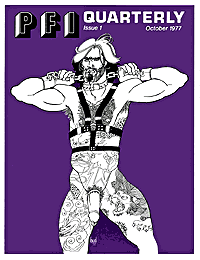
Issue 1.
The issue had 16 pages. Its original print run was 500 copies of the magazine and “Pin Pal” ad sheets. The cost of the job was just shy of $500. The subscription rate was $12.00 per year domestic, $14.00 overseas. The October 1977 issue was soon being put into envelopes and mailed to subscribers. Unfortunately I can’t remember how many actual subscribers we had at the time, but there were a number of copies left over. These eventually sold out over the counter and to new subscribers, and in time I had the issue reprinted.
As I mentioned earlier, this issue featured an interview with Doug. While the magazine was in production and being printed, he was out of the country. I knew that he was very closeted about his piercing activities, but as a tribute to him I still wanted to use a photo with the article. But there was no way to get ahold of him for his approval. As a solution I thought I could resolve the problem by having the printer “solarize” the image. That’s a process of making it so high contrast that it’s reduced to only a few tones, and I thought it would provide sufficient disguise so that he wouldn’t be quite so recognizable. Nowadays solarization can be done easily with a good computer program. Unfortunately, at the time I didn’t even know there was a word for what I wanted much less how to describe it. The printer tried to follow my instructions as he understood them, but the result was less than satisfactory.

Doug’s photographin PFIQ issue 1.
Doug returned as I was preparing the first issues to be mailed. I proudly presented him with a copy of this history making document, but my pride and enthusiasm were short lived. He was very displeased that I had included a recognizable picture of him. Caught between hurt and anger at myself, on the verge of tears, and knowing that it was too late and too expensive to have the magazine reprinted, I went to the hardware store after Doug left and bought a can of matte black spray paint. Returning home, flushed with upset and humiliation, I took a piece of thin cardboard and cut a rectangular hole in it the same size as the photo and started obliterating the evidence of my poor judgement by placing the stencil over the images one by one and spraying a swath of black paint across Doug’s face. As soon as the paint dried the magazines were stuffed back into their envelopes. I couldn’t wait to be rid of them as quickly as possible and immediately took the first batch to the post office just down the street. It’s possible some of these copies still exist in someone’s collection today. If so, they now know why Doug’s face is obliterated.
I’ve no recollection how many copies endured this defacing, but several hours later and before I could mutilate any more, Doug called me. He apologized for overreacting and said that since the only people who would be receiving the magazine would be piercing enthusiasts, many of whom already knew him, it seemed silly to worry about. Besides, the circulation was very small. As a result the remainder of the magazines were mailed out with his face unobscured.
Collectors may be interested to know that there is a subtle but distinct difference between the first edition of issue #1 and the reissue. In the first edition purple and brown inks were used on some of the inside pages. To save money on the reissue, only the cover has purple ink.
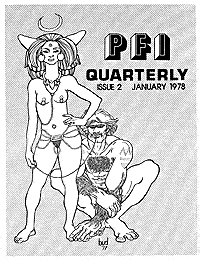
Issue 2.
-
The First Piercing Store Opens its Doors [Running The Gauntlet – By Jim Ward]
Written by

VII. The First Piercing Store Opens its Doors
While working from home may have been convenient, it also had its drawbacks. In essence you never leave work, so it’s hardly surprising when drunks show up on your doorstep at 3:00 in the morning wanting to get pierced. It also doesn’t help one’s credibility. For some time I realized that if piercing was ever going to be taken seriously, I’d have to move the business to a storefront.By the middle of 1978 I was able to generate enough cash flow to be able to seriously consider looking for a suitable location. Several factors were essential. Of course the rent had to be something reasonable. West Hollywood seemed like an excellent choice. Since the majority of my clients were gay men, it seemed logical to be in the heart of the gay ghetto.
I briefly considered the Silver Lake area because a lot of leathermen lived in that neighborhood. There were also a number of leather bars. But unfortunately it lay within the jurisdiction of the rabidly homophobic Rampart Division of the LAPD under an equally homophobic police chief, Ed Davis. Notorious for his raids on the area’s gay bars, Davis made headlines and enemies on the city counsel when he squandered a sizable chunk of the police budget marshalling a large force, including helicopters, to raid one of the leather bars that was having a slave auction to raise money for charity. He reasoned they were breaking the law because slavery is illegal. Were I to locate in Silver Lake, how long, I wondered, might it take for my fledgling business to fall victim to some cop with an agenda? At least West Hollywood had a sheriff’s department which seemed to get along well with the area’s residents and business owners. Because I hated driving in LA, I was perfectly happy to find something within walking distance of home.
West Hollywood in those days before it became an anti-business incorporated city was a genial community on the Eastern edge of Beverly Hills. Then, as now, the area was liberally dotted with showrooms catering to the interior design trade.
As fall approached, fortune smiled on me. On the corner of the main thoroughfare (Santa Monica Boulevard and Huntley Drive), about three and a half blocks from home, I saw a ‘For Lease’ sign. The space was only about eight hundred square feet, but the rent was within my budget and it provided everything I needed at the time.
The building owner was a crotchety, middle-aged, lush named Sid. At one time he’d had a design related business on the premises, but had reached retirement age and wanted to let his property be his source of income. At the time there were three other businesses in the building. If memory serves me correctly, there was a gay-owned vintage clothing store on the corner, a pro-dom on the second floor, and, briefly, a gay sex club run by the landlord in the basement. It was certainly a colorful location for my business.
I signed the lease in September and began the process of decorating and furnishing. Although he was frequently difficult, Sid and I got along well through the years, and Gauntlet had a presence in his building until its demise in 1998. Sid died a year or so before Gauntlet.
Before starting Gauntlet I had had many years of training and experience related to the design field. I’d studied three years at the New York School of Interior Design, worked for several designers, done picture framing, and worked in a paint and wallpaper store. When it came time to decorate my own business, I was ready.
By 1978 I had pretty well established purple as the color for body piercing. This had sprung directly from another of those products of gay creativity, the bandana or hanky code.
According to my research, some trace of the hanky code dates back to Gold Rush days, when dancers in all-male mining town saloons would divvy up into “fellers” and “gals,” those taking the women’s parts wearing identifying kerchiefs wrapped around their arms. But in the hands of a few gay men, it manifested into a unique cultural phenomenon that is still with us today.
“The hanky color code originated in the early 1970s primarily to distinguish specific sexual interests when the original SM (or at least DS)-orientated leather scene was enlarging—and clothing alone didn't reveal esoteric sexual interests. The first published hanky code was done by Ron Ernst who drew one up in collaboration with Alan Selby (the original Mr S) for their San Francisco store Leather N Things; this code was published in the Bay Area Reporter in 1972.”The color of the bandana and the pocket in which it was worn signaled one’s particular sexual interest. Worn in the left back pocket it meant you were a top or active participant; on the right, a bottom or passive partner. Over the years the list of color codes became quite long. Some have quipped that you need a color chart to decode all the subtle differences of hue and shade. In the early days the list was fairly short. Red meant you were into fist fucking, a particularly popular sport from the mid 70s until the advent of AIDS ten years later. Dark blue indicated an interest in fucking, light blue a taste for cocksucking. Black meant S/M; gray, bondage. Yellow and brown are self explanatory (more).
Drummer, a magazine for gay men into S/M that had begun about the same time as Gauntlet had published an article listing the common hanky code colors. I reasoned that piercing fans ought to have a color of their own. But what color? I didn’t have to look too far for inspiration — purple, the color associated with Jupiter, the planet associated in astrology with prosperity and good fortune; purple, the color draping Catholic and Anglican churches during Holy Week when they commemorate the day Jesus got pierced. It seemed ideal to me, and so I fired off a letter to the editor of Drummer decreeing purple as the official color for people into piercing. My letter was published, and in time, by continually reinforcing the message, it stuck.
Quite naturally purple had to be a significant element in my color scheme. While purple is quite common today in fashion and design, in 1978 it was not a particularly popular color. This presented me with a number of challenges from the start.
The business owner who’d previously occupied the store had put up a canvas awning. My original intent was to have a new awning made from purple canvas to fit the existing frame. On this would be painted the business name. Unfortunately there was no purple canvas to be had. Rather than go with another color I finally decided to have the existing awning painted and lettered instead.
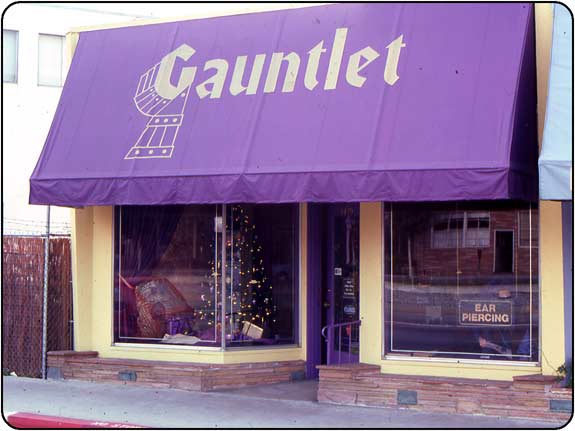
The exterior of the store with its purple awning
As for decorating the interior, some friends and T&P group members thought the motif should be “early dungeon” — dark with lots of black leather and chains. While certainly sexy for some, for lots of people this would be too intimidating. It might also create an impression of sleeze and a possibly unsanitary environment. For most people getting pierced is scary enough, and less edgy surroundings can help put them at ease. I envisioned a day when piercing would become popular with more than just gay S/M enthusiasts. I wanted a look that would be inviting to anyone who walked into the store.
A stylish wallpaper, something in which purple was a major element, would certainly be a good starting place. From working in a paint and wallpaper store I was familiar with many of the wallpaper designers and what they had to offer. So I got dressed up and headed for the newly opened Design Center to play interior designer.
Finding what I wanted proved to be a bigger challenge than I had anticipated. There was almost nothing in which purple was a significant keynote. While some companies will custom color a run of paper for a design job, it’s expensive and reasonable only for a large job. I only needed a few rolls of wallpaper.
What I finally settled on was beautiful, if a little over the top. It was a foil paper with an art nouveau motif of giant peacock feathers in shades of gold, orange, rose, and russet red with purple accents. The effect was quite dramatic. Some friends said it looked like a bordello. Others thought it was a little too gay. But once applied to the walls, with the trim and ceiling painted in a complementary purple, everyone had to admit the place looked elegant.
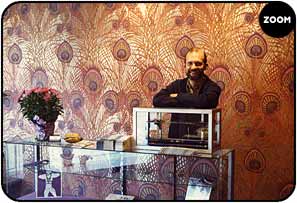

Left: The front counter. The wallpaper was a real eyecatcher.Right: Gordon, one of my first office assistants, at work in the newly opened store.
I really would have liked to have had purple carpet, but that was not to happen for several years. Until then we made do with the sandy beige carpet that covered the floor when I took occupancy. At one point a carpet dyeing service was called in to dye the carpet purple, but after they did a small, inconspicuous test area, the idea was scrapped. The best they were able to come up with was a sickly lavender which was not acceptable.
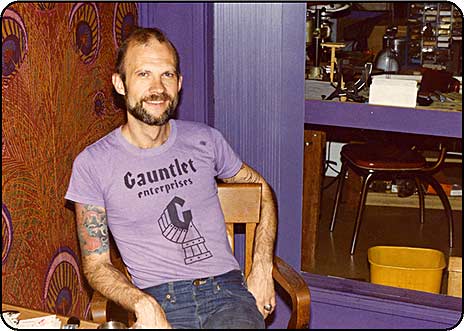
At my desk. Notice the jewelry making area directly behind me.
The vertical blinds could be closed to provide privacy when I was piercing.
The back half of the store was to serve double duty. There was to be an area where I would make jewelry and another screened off area where I would do the piercing. The back wall was covered with a mottled silver and white wallpaper. The remaining walls were painted white. Good lighting was important, and the white gave the area a clean reassuring feel.
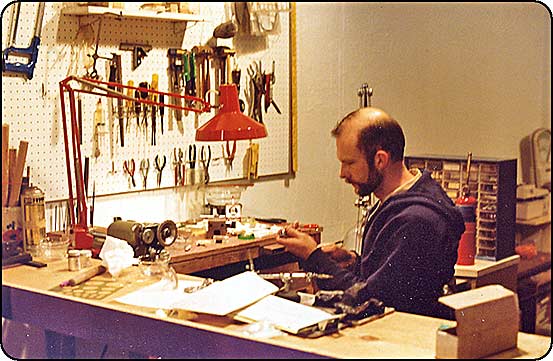
Making jewelry
As the decorating proceeded, plans for the grand opening were taking shape simultaneously. I designed invitations and had them printed. Fakir graciously provided a photo of his enlarged nipple piercing which appeared on the front. Well over a hundred invitations were sent out to enthusiasts all over the world.
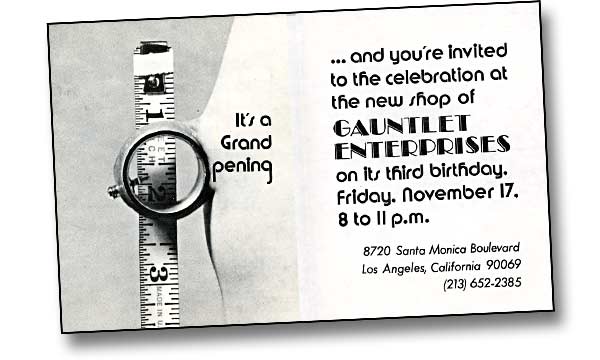
The grand opening invitation. Fakir Musafar provided the photo of his nipple.
The grand opening was scheduled for November 17, Gauntlet’s third anniversary. There was a whirlwind of activity in preparation. Refreshments had to be purchased, champagne iced, everything put in order. A local photographer named Charlie Airwaves was hired to take photographs. It was one of the biggest days of my life.
Guests began arriving around eight o’clock. My lover Eric and Doug were on hand to help me welcome them. Doug was in his element. For him this was the manifestation of a long-held dream.
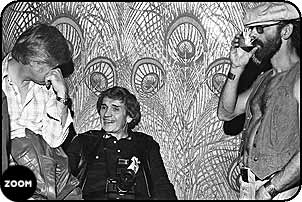

Left: Doug holding forth with members of the T&P group.
Right: My lover Eric chatting with Alayne, my bookkeeper.
(Both photos by Charlie Airwaves)
Throughout the evening over a hundred people attended the festivities. It was a historical event. I wonder if that many piercing enthusiasts had ever congregated in one location at the same time before. Among the many guests were my pal Rod, and Tom the librarian who had been so fatefully instrumental in bringing it all into being.
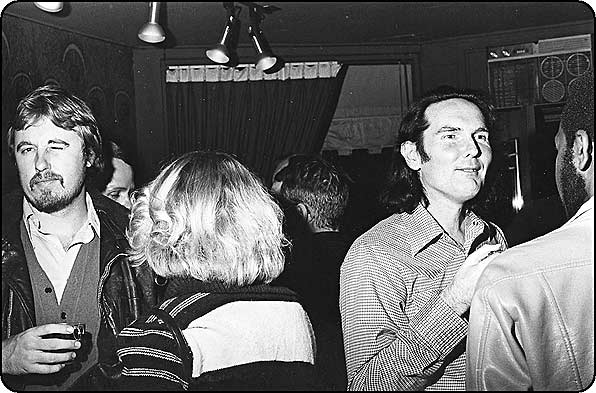
Among the guests was Tom the librarian (right facing forward)
who was responsible for bringing Doug and me together.
(Photo by Charlie Airwaves)
Members of the T&P group were out in force, among them Bud who would become known to the piercing world as Viking Navaro. From Orange County, pro-dom Mistress Antoinette showed up and was photographed with both Doug and I.

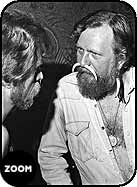
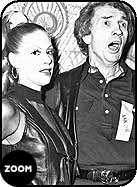

L-R:
1. Members of the T&P group in conversation (photo by Charlie Airwaves).
2. Decked out in Gauntlet-made septum tusks, Bud, AKA Viking Navaro,
converses with fellow enthusiasts (photo by Charlie Airwaves).
3. Doug caught in mid-yawn or mid-sentence with pro-dom Mistress Antoinette.
4. Mistress Antoinette and I catching a photo op.
So the opening night of the first store in the world devoted exclusively to body piercing came to an end. It was an event I will never forget. Who would have dreamed that in less than three decades there would be thousands of piercing establishments around the world following in its footsteps?

Next: The World’s First Piercing Magazine
Jim Ward is is one of the cofounders of body piercing as a public phenomena in his role both as owner of the original piercing studio Gauntlet and the original body modification magazine PFIQ, both long before BME staff had even entered highschool. He currently works as a designer in Calfornia where he lives with his partner. Copyright © 2004 BMEzine.com LLC. Requests to publish full, edited, or shortened versions must be confirmed in writing. For bibliographical purposes this article was first published July 31st, 2004 by BMEzine.com LLC in Toronto, Ontario, Canada

-
Bill O’Reilly Fears The Lizardman
Written by

Bill O’Reilly Fears The Lizardman
“The ACLU … are the most dangerous organization in the United States of America right now. There’s by far. There’s nobody even close to that. They’re, like, second next to Al Qaeda.”
– Bill O’Reilly, FOXNews (6/2/04)The first time I encountered Bill O’Reilly’s irrational views on body modification was some time ago when he appeared on Last Call with Carson Daly. I was flipping channels and came across the show, and having only heard a little about Bill at the time I decided to stop and get some firsthand experience of him. The thing that has stayed with me from that interview was Bill’s reaction to seeing Carson’s forearm tattoo. With no more provocation than the sight of the tattoo, O’Reilly began to voice his extreme disapproval, tinged with sorrow, over people — particularly young people like Carson — getting tattoos. I do not have a transcript but the phrase ‘hate to see young people ruining themselves’ sticks in my head. While those may not have been his exact words at that time, they are certainly in line with the position he continues to espouse today, often without any prodding.
Besides revealing his prejudice a propos of nothing, the other thing that makes this notable for me is the context. Here is a man (O’Reilly) who as the guest on the show is lamenting how someone younger than he is, with (at the time) two very strong television shows has ruined himself and his future by getting a tattoo. I really think that Bill would do better concerning himself with his own career than that of Carson who could likely rest comfortably on his laurels for the rest of his life already and shows few signs of slowing down. Also, as Carson was quick to point out, this particular tattoo is a tribute to his father. O’Reilly was hardly fazed at this, though it was enough for him to shift off from discussing Carson’s tattoo to tattoos in general and then letting the subject go for the moment. So, when faced with fact that he had ignorantly spouted off about a tattoo that by anyone’s standards would be a beautiful and solemn gesture he did not apologize or reconsider but simply went on pontificating, conveniently overlooking his misstep and the glaring exception to his argument sitting next to him.

Since this incident I have had the chance to hear O’Reilly denigrate tattoos and piercings regularly — most often in his radio broadcasts. When I am on the road I tend to search for talk radio and encounter him on the airwaves frequently. He often lumps being tattooed or pierced in with violent or antisocial behaviors, illiteracy, misogyny, and other undesirable qualities or activities. Sometimes he goes so far as to say that a visible tattoo or piercing is an indication that the wearer is a social degenerate. Frequently, he points to how people with visible tattoos or piercings will not be able to get jobs and thus make any contribution to society. Consider the following quotes:
“Already you see millions of young Americans covered with tattoos, unable to speak proper English, unwilling to read a book or a newspaper. How do you think these people are going to compete in our hypercompetitive economic marketplace? The answer is that millions of them will be unable to compete, and will be doomed to a low wage existence. IBM will not hire you if you have a tattoo on your neck.”“Thus, we now have 10-year-old boys calling little girls ‘bitches.’ We have 13-year-olds with tattoos and body piercings. We have poor children without parental guidance selling dope and carrying guns.”
My first question to Bill would be, where has this prejudice come from? It seems a bit too overdone, even for a pundit (the job description of which could easily read ‘making gross and unjustified generalizations’), to be simply a symptom of the residual Western puritanical stigma attached to most forms of body modification. Perhaps every pierced and tattooed person that Bill has ever encountered or heard of was an ignorant, violent, leech on society with no redeemable human values. Maybe he somehow managed to overlook all of the good people who are pierced and tattooed — the policemen, firemen, doctors, scientists, and just plain good folks (including ones with neck and hand tattoos that work for IBM — I know of a few) . I won’t deny that there are some truly repugnant people in the world and I will freely admit that some of those people are pierced and tattooed but there is something very important that Bill O’Reilly seems determined not to see:
Heroes have tattoos too.
In fact, if I were to over-generalize my experience in a similar manner I would be saying similar things about people without visible tattoos or piercings. Nearly every person who has ever accosted me for money or that I have observed or experienced acting poorly in public was not notably modified. Conversely, the nicest and most successful people I know are very publicly modified.
And this is why Bill O’Reilly fears me — and probably you too. We rip the carpet out from under his proverbial feet. As much as he would love to paint us all as exceptions that prove the rule, there are just too many of us spread across too many fields and endeavors. And here is a note to Bill and anyone else who wants to tread that path: In real logic, the exception never proves the rule. Furthermore, many tattooed people are not employees because they are employers!
If there is a silver lining to the success that allows O’Reilly spew his ignorant prejudice to such a large media audience it is that it means he will almost certainly never return to his former career as an educator. Yes, as he himself is often quick to point out, O’Reilly is a former teacher. Coming from a family of teachers and having teaching experience myself (ranging from elementary to college level); I shudder to imagine Bill O’Reilly entrusted with care of developing minds. Per his prejudice against body modification and despite claiming to hold personal freedom in high regard he advocates draconian methods in response to students who he describes as disrupting classrooms through body modification and or dress. I can only hope that his replacement was more enlightened and realized that instead of removing someone from the system until they comply by force, that issues of difference, including dress and body choices should be addressed for the benefit of all in the class. On that topic I would suggest Bill (and others) make a careful read of the columns by BME’s own Shannon Larratt on the subject:
As a final note, I will mention that I was contacted to appear as a guest on Bill O’Reilly’s show over a year ago when tongue splitting legislation stories were hot and I was getting the chance to debate some of the legislators, often pointing out their complete lack of any facts on the subject. Bill and his producers seemed interested in the story because they agreed with my take on it being an issue of freedom and pointless legislation of prejudice (The [Modified] Body Politic). I also suspect that the writers of the bill’s political affiliations may have played a role. However, the appearance and story was canceled. I cannot say for sure as to why — I was told that they decided to cut it in order to give more time to another story. Here is an alternate theory: Having contacted me and done some basic research on me based on information I directed them to on my website and BME, the producers and Bill realized that I would not be attacking the tongue splitting legislation but also look to press him on his stance on body modification. Could it be that Bill O’Reilly didn’t want to have to defend himself and give airtime to an educated well prepared opponent with a tattooed face?
 Erik Sprague
Erik Sprague
because the world NEEDS freaks…
Former doctoral candidate and philosophy degree holder Erik Sprague, the Lizardman (iam), is known around the world for his amazing transformation from man to lizard as well as his modern sideshow performance art. Need I say more?
Copyright © 2004 BMEzine.com LLC. Requests to republish must be confirmed in writing. For bibliographical purposes this article was first published July 27th, 2004 by BMEzine.com LLC in Toronto, Ontario, Canada.

